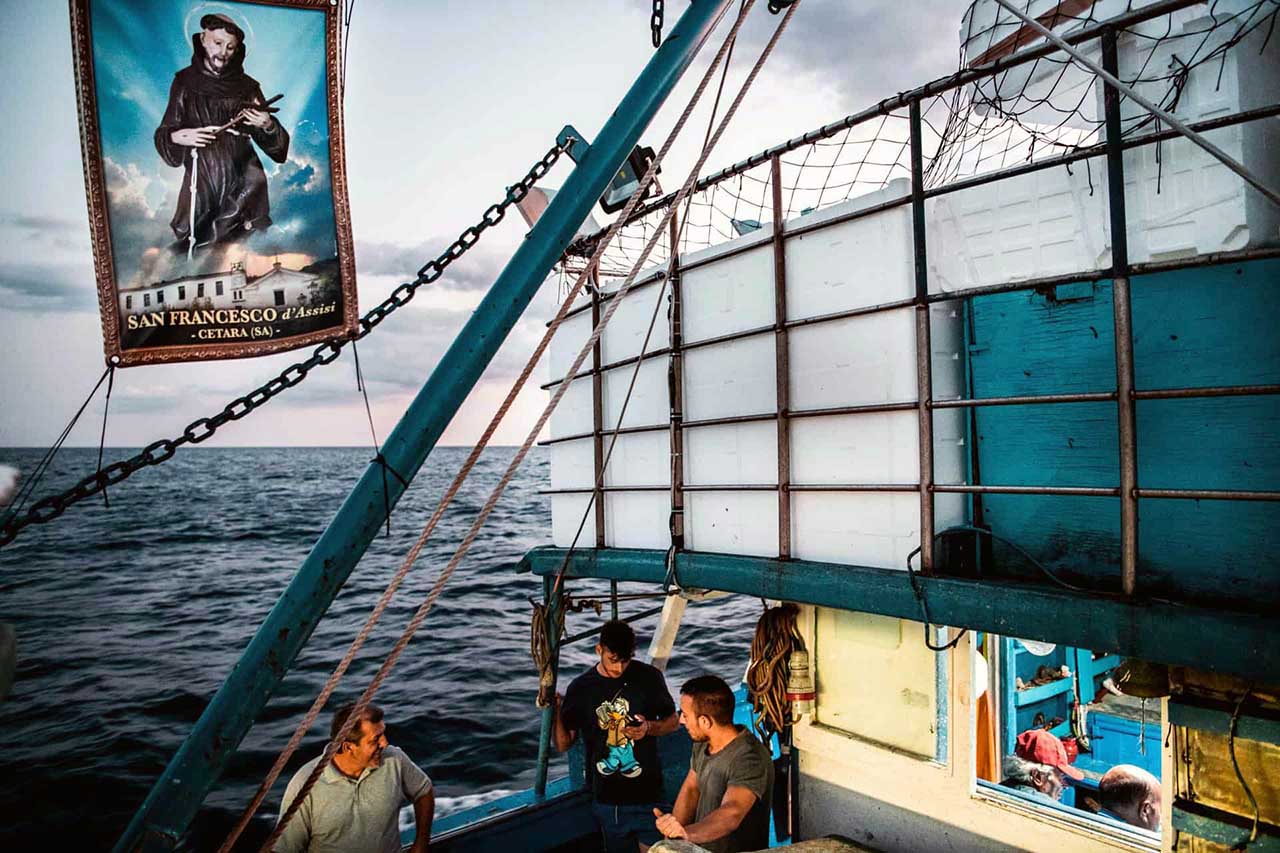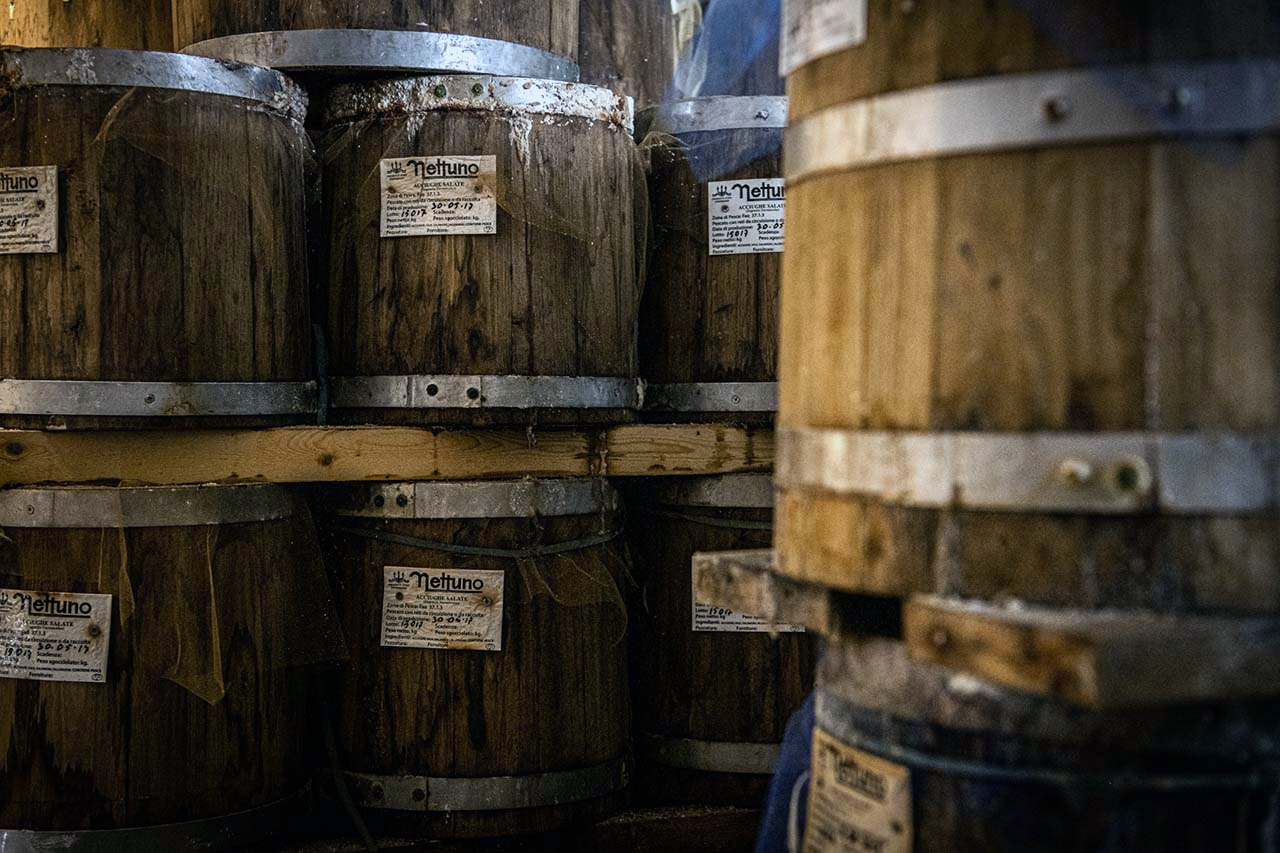At the end of 2020, Cetara’s colatura di alici (anchovy colatura) gained PDO recognition. From 2021, glass jars filled with the Amalfi Coast’s precious amber liquid will be available in local and national stores.
January 2nd, 2021. By Anna Volpicelli, photo by Vito Fusco
From March to October, Pierpaolo Ferrigno, a 36-year-old fisherman from Cetara, dives into the deep waters of the Gulf of Salerno every evening at 7 p.m. aboard the Sacra Famiglia, his fishing boat, to catch anchovies.
The waters of the Gulf are so salty that the anchovies find a fertile environment to grow and move. And it is in these waters that, for seven months, Pierpaolo, along with a team of 11 fishermen armed with purse seines and lampare, sail silently through the night waves.
“It’s a family tradition. Since I was ten, I have followed my father in this activity. From the sixth grade, already in the summer, I accompanied him. My life is the sea,” he says, smiling. From afar, the night’s darkness is illuminated by the lampare that marks the way for the anchovies that the fishermen pick up in groups. “We usually return to Cetara around 4 a.m. We return at dawn on Monday, Thursday, and Saturday mornings with the catch collected specifically for casting. Once ashore, the moose placed in special boxes filled with ice is delivered to the various producing companies.”
From antiquity to the present day
The origins of drippings are now well known. The preciousness of the amber liquid used in cooking dates back to the time of the Romans, who produced a sauce similar called garum. In the Middle Ages, a group of monks from Cetara recovered the recipe.
The story goes that the monks preserved salted anchovies in wooden barrels in August. Over time the process for obtaining the colatura has changed, although its foundations have remained the same. Fishing has also changed thanks to new technologies. In ancient times, it was practiced with a type of net called a menaide: a net arranged in a current, three hundred to four hundred meters long, made of a single sheet with all the same mesh.
Starting in the 1920s, the net was then replaced by the lampara, and in the late 1940s, a purse seine fishing system began to be adopted, enclosing the anchovies under the light source of lampare. Today these two methods are still carried out.
The recognition of the PDO
Last October, the colatura di alici di Cetara was officially granted the PDO mark to preserve these techniques and certify the uniqueness of the product. A milestone that was achieved thanks to the efforts of the Association for the Enhancement of Cetara’s Colatura di Alici.
It is an organization that unites producers, some local restaurants, and two Cetara shipowners. “In recent years, the colatura was beginning to attract interest locally, nationally, and internationally. Very often, some people come across non-authentic drippings. So we decided to start the procedure to obtain the PDO to protect our product and defend it from imitations,” Lucia Di Mauro, president of the Association and owner, together with her siblings, of the Iasa company in Salerno specializing, among other things, in anchovy colatura, tells us.
The family-owned company was founded 51 years ago by her Cetarese father, Francesco Di Mauro. “The Association was created precisely to guide the product to PDO status. For the first time, restaurateurs will finally be able to have their reserve of colatura and tap their product. They will then be the ones, together with the various producers and fishermen, to exalt this local treasure,” Di Mauro continues.

The long process
Currently, three restaurants in Cetara have participated in obtaining PDO certification, including San Pietro, La Cianciola, and Al Convento, and four producing companies, Iasa, Delfino, Armatore, and Nettuno. “Once caught, the anchovies arrive directly here at the farm. The process starts right from removing the heads and entrails from the fish, which are then put inside large containers filled with salt, and here they remain for 24 hours to let this salt bring out the amber liquid,” Giulio Giordano, owner of Nettuno, a company in Cetara, tells us.
At Nettuno, a famous local business, the first part of the job is entrusted to Angela Giordano, 74, and Giulio’s sister, who has been carrying on the family tradition since age 10. Sitting in front of an iron counter, her head bowed, Angela cleans anchovies with monk-like attention.
“My grandfather started this business,” Giulio says, showing the room where the various terzigni are stored, “we are the third generation.” The intense smell that permeates every area of the workshop comes thick to the nostrils. At first impact, your head spins, but slowly you get used to it. The room appears like an extensive library, where on the shelves, instead of books, are terzigni, so-called because they represent the third part of the wooden barrel. Inside these small barrels, the anchovies are placed to mature.
Once closed, weights are placed on top of the terzigni to facilitate pressure and, thus, the release of the liquid. “When they reach full maturation, by making a small hole under the terzigni, drop by drop, the liquid escapes. This operation takes at least three years,” Giulio tells us. After this long time, the fish left in the barrel, now dehydrated, is not thrown away but is delivered to some local companies that turn it into fish feed.

An actual work of art to be seen and enjoyed
Colatura di Alici represents the pride of all Cetaresians and the entire Amalfi Coast. So much so that in the small fishing village, a small museum has been set up inside the Saracen Tower, which residents call Torre Vicerale (Viceroy Tower) because it served as a sentinel for local communities. “Here have been collected all the ancient pieces belonging to our culture that should not be lost or worse yet forgotten,” explains Angela Speranza, Councillor for Culture, Tourism, and Communication in Cetara.
Ancient anchors, fishing nets, and purse seines alternate with contemporary art treasures such as some pieces of modern ceramics “that are a symbol and a testimony of the fisherman’s work, a fundamental figure from which the whole process of casting starts. This small museum represents our cultural and social heritage and our identity.” A legacy that is celebrated every year by entire families who, in December, serve tasty and flavorful dishes seasoned with anchovy colatura on the table. It is typically used to garnish spaghetti and fish or vegetable dishes. A genuine delicacy that, in 2021, may be available beyond local borders.
The new year will see the first glass bottles filled with colatura di alici di Cetara (Cetara anchovy sauce) with the DOP mark appearing in local stores and beyond. An unmistakable sign of belonging that well expresses, with clarity, the authenticity of a place and its true essence.
